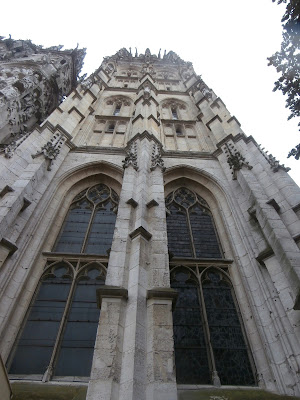Today we explored the old part of Rouen.
At the end of the block is the St Joan of Arc Church, museum, and the actual site where she was burned at the stake.
Some of the architecture:
During World War II, the fight for the liberation of France was hard. One of the deadliest bombings by the Allied bombers during the German occupation took place over Rouen April 18-19, 1944. 900 people were killed.
Rouen was heavily damaged during World War II - approximately 45% of the city was destroyed.
The city was liberated by the Canadians on 30 August 1944 after the breakout from Normandy.
There are still signs of the War in the city.
The Rouen Cathedral
The Rouen Cathedral was painted over and over again by the artist Monet. He painted it in all kinds of weather and at all times of the day. He tried to catch the light. With all the lacy edges there are LOTS of places to catch the light on this beautiful cathedral.
This cathedral is huge. Inside they have an exhibit that shows the history of the cathedral. It has had lots of fires through the centuries and bombing in World War II.
These building are across from the cathedral and I like to think one of those upstairs windows was Monet's that he painted the cathedral from!
The cathedral was not open until the afternoon so we walked a bit and went back to the hotel.
Back to the hotel for a rest.
To be continued. . .
______________________________________________
Our Itinerary from home:
At the end of the block is the St Joan of Arc Church, museum, and the actual site where she was burned at the stake.
 |
| The back side of the St Joan of Arc church. |
 |
| The stained glass window in the church |
The sign reads "The location where Joan of Arc was burnt on May 30, 1431.
Interesting to note, most of the residents of Rouen on May 30, 1431 supported Joan of Arc being burnt at the stake. Now, they are making quite a bit of money from tourists because of it.
 |
| Jen though this was interesting! |
During World War II, the fight for the liberation of France was hard. One of the deadliest bombings by the Allied bombers during the German occupation took place over Rouen April 18-19, 1944. 900 people were killed.
Rouen was heavily damaged during World War II - approximately 45% of the city was destroyed.
The city was liberated by the Canadians on 30 August 1944 after the breakout from Normandy.
There are still signs of the War in the city.
The Rouen Cathedral
The Rouen Cathedral was painted over and over again by the artist Monet. He painted it in all kinds of weather and at all times of the day. He tried to catch the light. With all the lacy edges there are LOTS of places to catch the light on this beautiful cathedral.
This cathedral is huge. Inside they have an exhibit that shows the history of the cathedral. It has had lots of fires through the centuries and bombing in World War II.
These building are across from the cathedral and I like to think one of those upstairs windows was Monet's that he painted the cathedral from!
 |
| This is a good example of an old half timbered building that had been stuccoed over. Now the stucco is being removed and you can see the old revealed. |
To be continued. . .
______________________________________________
Our Itinerary from home:
June
27~ Monday~ Day 12
Rouen
~ Rest at Hotel
de Bourgtheroulde
Breakfast
buffet included.
Things
to do:
GROCERIES?
SIGHTSEEING
RELAX
Sight
see
St.
Maclou's Church
St.
Ouen's Abbey
Rouen
Clock
Cathedrale
Notre-Dame de Rouen
Pre
pre-packing: kind of organize things a bit for the trip home
Go out to LUNCH AND DINNER: Restaurants that are Veg Friendly
Faites-Le Vous Meme - always have vegan and veg options
Les brochettes en folie's - french vegetarian
La
Suite Afghane
Rest'O'Rock Vegetarian
Friendly! 15 rue Thomas Corneille American Style
Restaurant- Burgers, Chicken, Mexican
Le
Radjasthan - Indian 17 Rue De la pie Open on Sunday Easy
menu for vegetarian
So
Falafel 62 Rue Louis Ricard 11:30AM–2:30PM, 7–10:30PM
Closed on Sunday
Crêperie
Roland buckwheat
crepe was full of onions, spinach, mushrooms, and tomatoes,































No comments:
Post a Comment